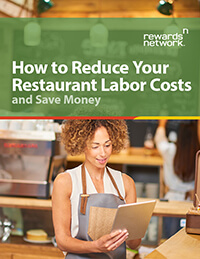On average, three out of every four employees in your restaurant won’t be with you this time next year. And it’s going to cost you big.
Do you have the extra money to lose when employees leave?
In our brand-new eBook, we walk through how to forecast your restaurant labor costs accurately, and then pinpoint areas of your business that can help reduce those labor costs, including:
- Smarter — not less — restaurant hiring
- More thorough restaurant staff training
- Operational changes that promote efficiency
Download this free e-Book today to explore how your restaurant can keep its labor costs down, without cutting the critical help you need to run your business effectively.
Excerpt from Chapter 1:
Three out of every four employees in your restaurant won’t be with you this time next year — that is, if averaged hospitality business statistics bear out for your business.
Industry turnover rates are at nearly 73% , and it’s caused by more than just the hassle of everyday rehiring that restaurants have to deal with. Restaurant labor costs are growing every day, but it’s not just base salaries that you need to worry about.
According to research compiled by RAIL Media, the average cost of replacing an employee — salary aside — is $5,864 each person. For the average full-service restaurant operator, that could run up to $146,000 annually.
Wow, right?
Nearly six thousand dollars goes right down the drain every time someone walks out your door for the last time, between the cost of:
– hours lost to interviewing,
– advertising the position,
– training a new staff person,
– accounting for early mistakes
– the loss of customers from temporarily decreased customer service, or
– the cost of overtime to balance it out.
And the trouble is, this brand of restaurant labor costs is nearly invisible on your balance sheet. But that doesn’t mean they aren’t there.
The good news is, hidden restaurant labor costs from turnover are often avoidable, at least to a degree. Yes, very few restaurants can get their employee turnover rate down to zero, any more than they can completely eliminate food waste or over-scheduling.
But there are ways to help reduce your restaurant labor costs. In the following chapters, we look at how to accurately forecast your labor needs, in order to avoid the hidden costs of overstaffing and understaffing. Then we focus on three core areas of competency for reducing labor costs: hiring, training, and operational changes.
But before you can make changes, you need to know what actual costs you’re dealing with. Enter: restaurant labor forecasting.
It’s one of the toughest calculations a restaurant owner needs to make — and the decisions you make in the process can help you achieve success… or throw your establishment into chaos.
But restaurant labor cost forecasting isn’t like throwing a dart and hoping it lands. There’s a method to the madness that breaks down how much you should be spending on labor, what “counts” as a genuine labor cost, and then how to use your overall sales to forecast how you’ll need to schedule at any given time.
And it all starts with your total sales.
In the restaurant industry, ideal labor costs are determined by comparison to your total sales in a given period of time. A common recommendation for cost ratio is to allocate around 60 percent of their total sales to food and labor, otherwise known as your “prime costs.” The more you spend on labor, the less you have to spend on food, and vice versa, so the general recommendation is not to exceed 30 percent of your total sales on either.
Management salaries should not exceed 10 percent of sales for either full service or quick serve. This amount is included in the 30 percent recommendation, leaving 20 percent of your total sales in a given period for non-managerial staff.
So, for instance, if your restaurant makes $10,000 in a given week in total sales, your labor costs (hourly, salaried, and management combined) should not be more than $3,000 (with another $3,000 allocated to food costs). Of the remaining $4,000 in sales, keep in mind how much goes to rent, utilities, equipment maintenance, upkeep of small wares, and — most critical of all — federal, state, and local taxes.
It’s no wonder the average restaurateur only manages a profit margin somewhere between two and six percent.
Central to your restaurant labor costs are hourly wages and salaries for your staff.
You likely pay different employees at different rates, depending on their role and length of service. Most servers will make below minimum wage (The federal government requires a wage of at least $2.13 per hour be paid to employees that receive at least $30 per month in tips. This may be higher in some states and local municipalities, however.).
But your cooks, dishwasher, bussers, hosts, and any other staff not receiving tips will be making at least minimum wage for your local area.
*Statistics footnoted in eBook appendix.
